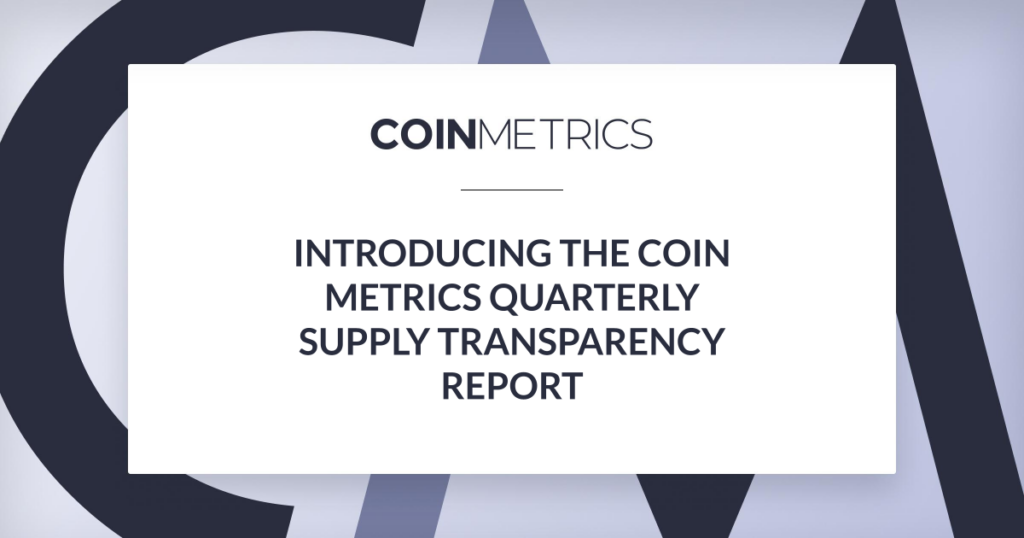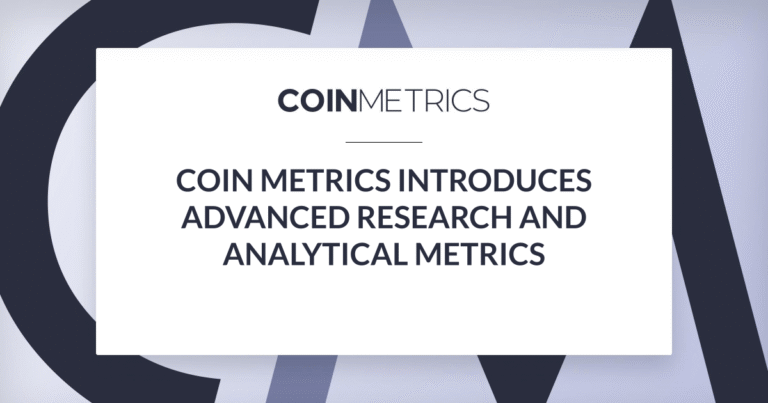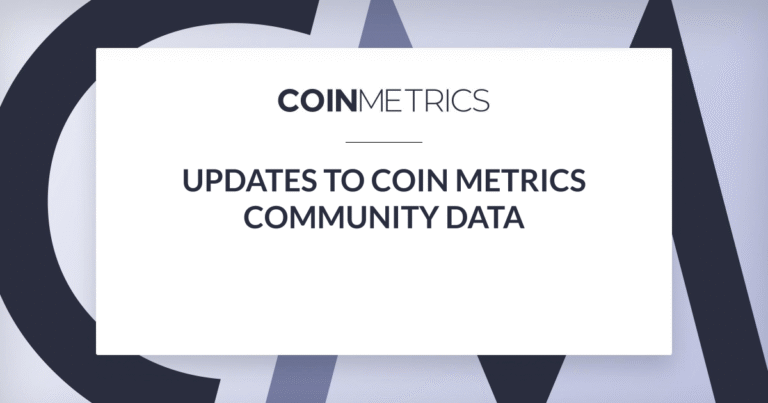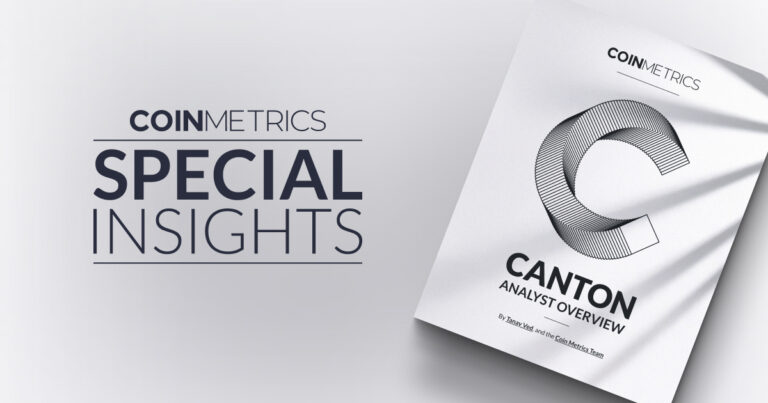Key Takeaways
- Coin Metrics will release Quarterly Supply Transparency Reports, with today’s Q2 Supply Transparency Report being the first of its kind. This report hopes to bring insight into the supply dynamics of cryptoassets, specifically focusing on the activities of key categories of stakeholders.
- Changes in free float over the last year can provide clarity into the implied level of inflation as a result of non-liquid assets entering the market. For example, Crypto.com has an implied inflation rate of 145%, XRP and 0x have implied inflation rates of 17%, and Stellar has an implied inflation rate of 13%.
- The 0x foundation seems to have taken the opportunity to put their treasury to work through Q2, taking advantage of DeFi yields after the launch of Compound.
- Many PoW assets experienced inflation adjustments through the month, including BTC, BCH, BSV, and BTG which all experienced halvings in inflation rates.
- The amount of Bitcoin that moved into the strategic long term holder category had its largest quarterly increase since Q2 2019, removing another 103K BTC from Free Float Supply.
Intro
Part of Coin Metrics’ mission is to provide the community with transparent cryptoasset market and network data that allows investors to make the most informed decisions. One of our most recent metrics, Free Float Supply, has provided Coin Metrics with the opportunity to gain visibility into the activities of strategic stakeholders in cryptoasset networks and report our findings to our community on a quarterly basis. We perceive this type of reporting to be akin to traditional equity markets which mandate that company insiders and other strategic stakeholders (e.g. those that own >5% of shares) report their holdings to governing bodies, which in turn are promptly made public.
Having only released the Free Float Metrics one month ago, our first report is being released slightly behind schedule. But moving forward the Quarterly Transparency Report will be released on a regular schedule, which we will be announcing soon.
Free Float Refresher
Free Float Supply is a new metric that aims to better represent a cryptoasset’s liquid supply in the market. By restricting categories of network stakeholders that are not considered to provide immediate liquidity to markets, this metric provides investors with a different perspective on ‘available’ supply that can help to inform portfolio construction and design, improve valuation techniques, and provide insights into liquidity and inflation.
The key categories of stakeholders that are considered to restrict liquidity for markets in the calculation of Free Float are:
- Foundations, companies and founding teams
- Addresses that have been inactive for over 5 years (long term strategic/lost)
- Addresses that stake in a smart contract to partake in governance and long-term strategic outcomes of a network without any direct monetary incentive to do so
- Holders that are subject to on-chain vesting
- Addresses that are considered burned or provably lost
For more detailed definitions, calculation methodology and explainers of Free Float Supply you can reference our Medium Blog Methodology Announcement or our SOTN Issue 57 launch announcement.
Transparency Reporting
Before we dive into the results and some analysis of the Supply Transparency Report, there are a few important disclaimers we would like to make:
- In the current unregulated state of pseudonymous cryptoassets, supply tracking is an art, not a science. Whilst we hope to represent the most accurate state, we acknowledge that identifying everything to a 100% accuracy can be near impossible in certain cases.
- Coin Metrics tracks the movement of tokens into and out of a tagged set of addresses, continually updating where appropriate. We do not make any conclusions as to why funds have moved and in no way insinuate that movement implies that assets are being sold.
- Whilst in cases we isolate the activity of a group of stakeholders, for full context, it is important to observe and understand the aggregate movement of restricted supply. There are cases where a foundation has moved a large percentage of assets, but sent them to burn addresses or other restricted addresses such as team members. These types of transactions do not increase an asset’s Free Float Supply.
- Coin Metrics’ asset coverage is currently limited to the following assets: ADA, BAT, BCH, BSV, BTC, BUSD, CRO, DASH, DGB, DOGE, ETC, ETH, FTT, HT, LINK, LTC, MKR, NEO, PAX, XLM, XMR, XRP, XTZ, USDC, USDT (on ETH, TRX and Omni), and ZRX.
- The value of address activity in this report is defined as the change in address balance multiplied by the Coin Metrics UTC Close Reference Rate for that day.
Free Float Supply Inflation
At the highest level, analyzing and understanding the changes in Free Float Supply have allowed Coin Metrics to identify and better understand the inflation rate of cryptoassets. It is widely known that Proof of Work or Proof of Stake blockchains have a rate of inflation from the issuance of tokens to miners/stakers. But what is less understood is the inflation rate of cryptoassets like Stellar, Cardano, XRP, or Chainlink. Whilst these tokens all have fixed or deflationary total on-chain supplies, the transition of restricted assets (such as those held by stakeholders) into the supply available to the market can be perceived as inflation.
Evidenced above, Free Float Inflation Rates across cryptoassets vary vastly. There are also several results that may seem non-intuitive at first glance, again highlighting the importance of understanding the full context of an asset before passing judgment. Some of the glaring oddities include:
- Huobi Token’s high deflation – Whilst Huobi undergoes routine token burns, on March 1, 2020, Huobi burned 147.4m HT of a total 500m outstanding HT. This one-off burn followed a community vote to remove assets assigned to the Platform Operation and Investor Protection Fund.
- In instances where a cryptoasset’s Free Float Supply is relatively small compared to its total On-Chain Supply, new issuances from foundation addresses can significantly impact inflation levels, as witnessed in the case of Crypto.com Coin (CRO).
- Dogecoin deflation – In the case of blockchains that are older than 5 years, Coin Metrics Network Data tools identify addresses whose assets have not been sent in over 5 years. Assets in these addresses are classified as belonging to long term strategic holders of a network and thus considered restricted from liquid supply. In the case of DOGE over the last 12 months, assets that have fallen into this category have been larger than those issued by the mining issuance schedule, thus resulting in a net deflation of Free Float Supply.
| Change from preceding quarter | 12 month change | ||||
| 2019 Q3 | 2019 Q4 | 2020Q1 | 2020Q2 | ||
| Dogecoin Free Float | (2,428,805,927) | 83,690,261 | (702,309,000) | 1,033,610,088 | (2,013,814,578) |
| Current Supply | 1,257,709,852 | 1,269,780,000 | 1,251,120,000 | 1,250,530,000 | 5,029,139,852 |
| Foundation | – | – | – | – | – |
| Team | – | – | – | – | – |
| Lost | – | – | – | – | – |
| Governance | – | – | – | – | – |
| Long term | 3,686,515,779 | 1,186,089,739 | 1,953,429,000 | 216,919,912 | 7,042,954,430 |
In the early stages of crypto assets, the primary categories of stakeholders that restrict supply are foundations/companies and team members. Very few chains have aged more than 5 years, thus have no ‘provably’ long term strategic holders, and there has been little burning that has taken place other than from some revenue-generating businesses that operate tokens (e.g. exchanges like FTX or Huobi). To that extent, the majority of changes to supply disclosed in the Quarterly Supply Transparency Report are from the movement from Foundation/Company or Team owned addresses.
Foundation/Company Restricted Supply
The chart below displays the foundations/companies that have been most active over the last 12 months manage some of the largest market capitalization crypto assets, including XRP, Stellar, Crypto.com Coin and Huobi.
Note 1: In March 2020, Huobi Foundation burned $422M worth of HT
Note 2: In November 2019, Stellar Foundation burned $4.14B worth of XLM
The net value of cryptoassets that moved outside of identified Foundation/Company controlled addresses in Q2 2020 was $743M, down from $891M during the previous quarter ($148M less). However, on closer observation, $422M of the assets moved outside of foundation addresses in Q1 2020 were from the Huobi burn of 147M HT. If we were to exclude this from Q1 values since it was a burn, distribution of assets from foundation address increased $274M or 58%.
Team Restricted Supply
Of the team owned address activity, it was XRP, FTX, Crypto.com Coin, and Chainlink that were the most active in the Coin Metrics coverage universe. The activity from identified FTX and Crypto.com Team addresses led to net credits to those accounts, solely from foundation distributions. Where-as the identified Team address activity from XRP and Chainlink led to net debits (i.e. distributions from these accounts that increased Free Float Supply).
The net value of cryptoassets that moved outside of identified Company Team addresses in Q2 2020 was $9.4M, down from $32.0M during the previous quarter ($23M less). It is worth noting though that the largest team address activity during Q2 was the credit of $67M CRO to Crypto.com Coin team addresses, without which the net value of cryptoassets that moved outside of Company Team controlled addresses would have been $76.5M.
Some interesting observations
Through the process of identifying and analyzing tagged addresses and their activity there are some fun insights that can be generated. During Q2 2020 some of the fun insights observed by the Coin Metrics Team were:
- Not ones to let their treasury assets remain dormant, the 0x Foundation capitalized on the opportunity to achieve some yield on their assets during Q2 following the launch of Compound’s yield farming that offered high APY returns as well as COMP distributions for early participants. During Q2, the Foundation sent ~50% of the 0x: Multisig funds to Compound in 4 10M ZRX transactions (1, 2, 3 and 4).
- Another crypto savvy crowd this month was some of the BAT team members, some of whom also took the opportunity to chase high yield and send funds to Compound. Whilst other team members forwent the opportunity to farm, favoring the opportunity to send assets to exchanges whilst the price of BAT was relatively high.
- The programmatic issuance rates of many Proof of Work assets reduced in Q2 2020, with assets such as Bitcoin, Bitcoin Cash, and Bitcoin SV all experiencing halvings, and assets such as DASH and ETC undergoing changes to their issuance rates as well.
- The amount of Bitcoin that moved into the strategic long term holder category had its largest quarterly increase since Q2 2019, removing another 103K BTC from Free Float Supply.
Conclusion
In traditional capital markets, ‘insider’ trading is highly regulated, can only be done under certain conditions and must be reported to public markets in a timely manner. In crypto markets, this standard does not and may not ever exist. However, through increased transparency initiatives, the cryptoasset ecosystem could get close to generating a similar standard. However, in lieu of this existing, changes in identified key stakeholder categories can provide markets with some degree of transparency.
This is the essence of what Coin Metrics strives to provide our community with the Quarterly Free Float Supply Transparency Report. We hope that this report can be another tool that provides more insight into market dynamics and help the community better evaluate the cryptoasset ecosystem and make more informed investment decisions.



